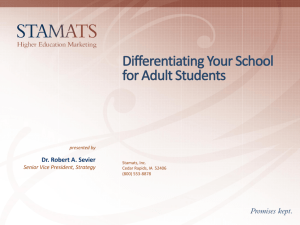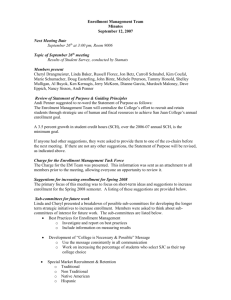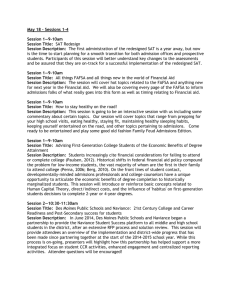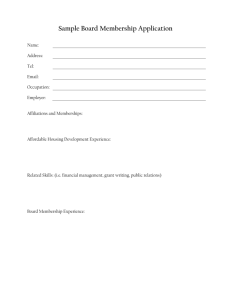Institutional Vulnerability and Strategic Responses in Today's
advertisement
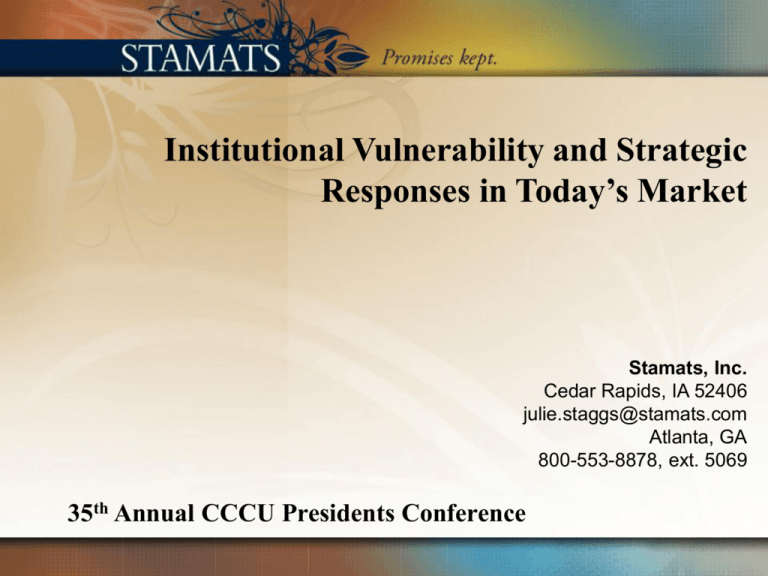
Institutional Vulnerability and Strategic Responses in Today’s Market Stamats, Inc. Cedar Rapids, IA 52406 julie.staggs@stamats.com Atlanta, GA 800-553-8878, ext. 5069 35th Annual CCCU Presidents Conference About Stamats Stamats is recognized and respected as the nation’s higher education integrated marketing thought leader. Our comprehensive array of innovative services has set the standard for pairing insightful, research-based strategic counsel with compelling creative solutions. We promise our clients the highest level of professional service and attention to detail in the industry because, in the end, we know our success is measured entirely by theirs. Research, Planning, and Consulting Services Creative Services • Image, perception, and brand studies • Creative concepting • Recruiting, marketing, brand, and academic program marketability audits • Web strategies • Recruiting and advancement publications • Tuition pricing elasticity and brand value studies © 2011 Stamats, Inc. - 2 Stamats on Your Campus Stamats has a wide array of presentations & workshops—like this one—that we conduct on campus for departments, senior leadership teams, and boards A partial list of sessions includes: • Major Trends That Will Impact Your Ability to Recruit Students, Raise Dollars, and Market Your Institution • Moving Ahead With Confidence • Developing an Integrated Marketing/Brand Marketing Strategy Please contact me for a complete list or to discuss a session for you in greater detail. julie.staggs@stamats.com Overview • The perfect storm • A tough marketplace • How students and parents will react • Colleges in the middle • “Move ahead” recommendations in: – Leadership and governance – Academic programming – Marketing – Fundraising – Recruiting © 2011 Stamats, Inc. - 4 © 2011 Stamats, Inc. - 5 Third Rail Issues • As you think about this presentation, consider which of the issues we will discuss might have third rail implications for you? The Perfect Storm • A confluence of four gales: – Changing demography – Rising cost to attend – Increased competition for students and donated dollars – Duress in the economy among: Students and families Donors Creditors © 2011 Stamats, Inc. - 7 Projected Number of High School Graduates Total of Public and Private Institutions 4.5 4 3.5 3 2 1.5 Millions 2.5 Projected Actual 1 0.5 Sources: National Center for Education Statistics 2018 2017 2016 2015 2014 2013 2012 2011 2010 2009 2008 2007 2006 2005 2004 2003 2002 2001 2000 1999 1998 1997 1996 1995 1994 1993 0 Projected Change in H.S. Graduates to 2018–19 +6 -9 -13 -20 0 +15 +34 +4 -1 -11 +53 +11 +33 +30 +5 +10 +4 +6 +59 -12 -8 +7 +15 +1 +6 +40 +5 0 +3 +13 +22 +11 -9 +18 -16 -8 -6 -21 -4 -1 +17 -7 -19 +33 +7 > 20% +8 +11 +41 +11% to +20% 0% to +10% -19 -6 +23 Decreases Source: U.S. Department of Education, National Center for Education Statistics, December 2008 © 2011 Stamats, Inc. - 9 U.S. Population Growth by Ethnicity (Number in Thousands) 400000 350000 300000 250000 Hispanic Caucasian Black Asian/Pacific Islander American Indian 200000 150000 100000 50000 0 1997 2000 2005 2011 2015 2020 2025 2030 2035 2040 2045 2050 (Year) • Minority population rising to about 50% of population by 2050 • 76% of Asian Americans have college degrees (only 67% of whites, 9% of blacks, and 7% of Hispanics have degrees) • Asians account for 26% of freshmen at MIT, 24% at Stanford, 19% at Harvard, 15% at the University of Chicago, 17% at Cornell. By 2011, >50% at UC schools Sources: U.S. Census Data, The College Board © 2011 Stamats, Inc. - 10 Majors of Interest to Prospective Students • • Public-bound – Undecided (8%) – Business (10%) – Nursing (7%) – Education (7%) – Engineering (6%) – Psychology (5%) • Fastest-growing majors – Business – Social sciences and history – Education – Health professionals and related clinical sciences – Psychology – Visual and performing arts – Communication, journalism, and related programs – Biological and biomedical sciences – Engineering Private-bound – Undecided (7%) – Business (9%) – Nursing (5%) – Education (6%) – Engineering (6%) – Psychology (7%) Source: The College Board and Stamats’ 2009 Spring TeensTALK® © 2011 Stamats, Inc. - 11 Fastest Growing Occupations • 2008–2014: – Network systems and data communications analyst – Nursing – Physician assistant – Computer software/systems engineer – Physical therapist – Medical researcher – Occupational therapist – Network and computer systems administrator – Engineering (environmental) – Elder care/social services – Energy, especially renewable – Security – Government service Sources: Business 2.0, USA Today © 2011 Stamats, Inc. - 12 Registered 501(c)(3) Organizations – 1995–2008 1,186,915 1,128,367 1,064,191 1,045,979 1,010,395 964,418 909,574 865,096 819,008 773,934 733,790 692,524 654,186 626,225 1995 1996 1997 1998 1999 2000 2001 2002 2003 2004 2005 2006 2007 2008 Source: Giving USA 2008 © 2011 Stamats, Inc. - 13 Tough Times – Jobs • In December 2010 – Unemployed: 15.1 million – Unemployment rate: 9.8% (up from 9.6 last three months) • December 2010 unemployment – key states – Ohio 10.1% – Illinois 10.1% – Michigan 13.1% – Pennsylvania – California • 9.2% 12.4% The number of long-term unemployed, those without a job for 27 weeks or more is at 6.3 million – Accounts for 41.9 percent of the unemployed • 6.1:1 ratio of people looking for jobs to job openings © 2010 Stamats, Inc. - 14 This will be a jobless recovery. © 2011 Stamats, Inc. - 15 Tough Times – Housing • 1/8 homeowners owe more on their house than it is worth • 1 in 45 homes are in foreclosure – There are 3,141 counties in the US; half the foreclosures are in 35 counties © 2011 Stamats, Inc. - 16 The economy is not the cause of many of the problems that are facing higher education. It has merely exacerbated issues and trends that have long been in play. © 2011 Stamats, Inc. - 17 The biggest indicator of institutional success is not the number of students or even your discount rate. The key number is net tuition revenue. Many privates had record enrollment this fall, but many of those schools also missed their net tuition revenue goals. © 2011 Stamats, Inc. - 18 We Can Expect – Students and Families • The big issue in their minds: Affordability • Students will apply to more and more schools • More students will opt for two- and four-year publics and for-profits • Students will transfer more often • Students will seek and expect more financial assistance • Students will be wary of aid packages that are predominantly loan based • More students will need to work while attending school • Students will flock to majors with clear job prospects • Students will attend school closer to home, even online • Parents will become even more involved in the college-choice process © 2011 Stamats, Inc. - 19 A Bit About Graduate Students © 2011 Stamats, Inc. - 20 Chronicle: College 2020 • Three types of schools: – Flagships and well-branded Will do well – The colleges in the middle Unknown privates with precarious finances that largely focus on residential, full-time students – Commodity (public and private, for-profit) Most will at least do OK; some will do well © 2011 Stamats, Inc. - 21 Eight Key Areas • Drawing on research, existing literature, and best practices, let’s look at the colleges in the middle through eight lenses: 1. Institutional type and description 2. Leadership and governance 3. Finance 4. Academic programming 5. Recruiting and financial aid 6. Retention 7. Fundraising 8. Marketing © 2011 Stamats, Inc. - 22 Queuing Up on the Front Porch • • Every college has at least some of these issues Colleges in the middle have a preponderance of these issues © 2011 Stamats, Inc. - 23 Institutional Type and Description • • • • • • • Private Rural/remote Small < 2,000 students Tuition dependent High discount rate Insufficient net tuition revenue Focus almost exclusively on traditional, full-time students © 2011 Stamats, Inc. - 24 Leadership and Governance: • • • • • • • • • • • • President has been in place for <4 years or >12 years Vision is not compelling nor differentiating Senior team is not cohesive Managing rather than leading Trustees and senior team are at cross-purposes Unable to identify blue ocean initiatives Faculty are bimodal: <35 and >55 Inability to agree on challenges school is facing Unable to make tough decisions in a timely fashion No real commitment to execution Cut resources in revenue-generation areas: – Recruiting – Fundraising – New programs No reward system in place that recognizes success © 2011 Stamats, Inc. - 25 Finance • • • • • • • • • • • • • Cost to attend is higher than major competitors Less than 3:1 ratio between endowment and operating budgets No cash reserves Short-term “bridge” financing required in final quarter of academic year Increase in uncollectable receivables Debt service more than 10% of annual budget Few unallocated dollars (little ability to invest in a blue ocean initiative) Few strategic alliances/networks/associations/consortia that allow you to achieve economies of scale Bond rating has been lowered Salary freezes Deferred maintenance Reductions or eliminations to retirement contributions Suspension of capital expenditures © 2011 Stamats, Inc. - 26 Most institutions can no longer afford to be what they’ve become. – Robert Dickeson © 2011 Stamats, Inc. - 27 Academic Programming • • • • • • • • • Focus largely/solely on liberal arts; much less emphasis given to pre-professional programs Academic leadership and faculty refuse to recognize marketplace trends Traditional faculty undermine new academic initiatives No new degree program offered in last two years or degree programs designed without marketplace data Takes longer than one year to bring new program on line Academic core is overly complex – Precludes transfer-student recruiting – Encourages academic featherbedding Chasing too many different accreditations Academic programs are largely indistinguishable from competitors Too many majors with too few students © 2011 Stamats, Inc. - 28 If you don’t believe in reincarnation, come back as an academic program and enjoy eternal life. – Robert Dickeson © 2011 Stamats, Inc. - 29 Recruiting and Financial Aid • Understaffed or staff is not seasoned • Focus largely on residential undergraduate students • No segmentation of prospective students • No transfer recruiting strategy • Aid for current students is disproportionately loan based • Non-loan aid is disproportionally focused on new or returning students • Have a high discount rate (uncertain brand value) • • Qualification for federal financial aid has been downgraded Parents push back on tuition increases; insist on repackaging of aid © 2011 Stamats, Inc. - 30 Retention • Have not developed a profile of a persisting student • Non-existent or ineffective first-year experience program • No “early warning” system • Pressure to get the class has undermined ability to shape the class – More students who are not a good fit – Students from the lower third of their high school class have less than a 20% probability of graduating in eight years (Townsley) • First year to second year and four-, five-, and six-year graduation rates are slipping © 2011 Stamats, Inc. - 31 Fundraising • Understaffed or staff is not seasoned • Annual giving is flat or declining – Less than 20% of alumni give to annual fund – Still doing annual fund annually • Capital giving is flat or declining • Campaigns are taking longer to close • Donors backing out of their commitments • Trustees do not financially support the institution at a significant level • Size of donor pool is stagnant • No giving pyramid © 2011 Stamats, Inc. - 32 Marketing • Marketing is seen only as promotion • Political issues are confused as marketing issues • No valued and differentiating brand • Have not embraced an integrated marketing model • Marketing plan does not dovetail with recruiting and fundraising plans • No consistent use of measurement to determine marketing effectiveness © 2011 Stamats, Inc. - 33 Is the Model Broken? • Our historic model of higher education depends on a sufficient number of traditional-aged students who are willing to pay a large portion of their tuition • Considerable data suggests that this pool of students is declining and there is no data to suggest that, at least nationally, the pool will get larger • If schools that largely serve traditional students wish to get larger, someone has to get smaller • In the future, full-time, residential, private higher education will simply be beyond the reach of anyone but the most affluent © 2011 Stamats, Inc. - 34 Living Within Our Means • The biggest challenge facing higher education is the need to align mission/vision with available resources • Requires: – Data – Vision – Political will – Decision-making © 2010 Stamats, Inc. - 35 So How Do We Respond? • Let me offer “top line” suggestions in five areas: – Leadership and governance – Academic programming – Recruiting and financial aid – Fundraising – Integrated marketing • I am going to leave out finance because in many cases financial issues occur because of problems in the five areas outlined above • Before we proceed, let’s lay a foundation © 2011 Stamats, Inc. - 36 Demystifying Turnarounds • If you look at the true college turnarounds (the Elons, the USCs, the Highpoints, the NYUs) they all have six common denominators: – Great leadership – Strong senior team – Compelling vision – Board support – The ability to raise money – A willingness to stay the course © 2011 Stamats, Inc. - 37 The single biggest challenge facing colleges is cost. © 2011 Stamats, Inc. - 38 Why College Costs So Much…an ongoing conversation • Yes, colleges are labor intensive (estimated at 75% of cost) • But some bad practices have significantly contributed to the cost run up – – – – – – – – – – – – – Focus on “purchasing” expensive inputs Tuition discounting Increasing debt service Consumerification (confusion over student “wants” vs student “needs”) Including athletics Technology Rise in number of middle managers Too many majors with too few students Unsustainable student/faculty ratio Too many academic departments Complex cores designed, in part, to keep faculty busy Number of credit hours for a major or to satisfy core continues to climb Federal and state compliance (regulation) Layers of accreditation that often serve the institution rather than students © 2011 Stamats, Inc. - 39 Students and parents are both the victims and perpetrators of the cost escalation – Larry Large © 2011 Stamats, Inc. - 40 Sources of Revenue • • • • • • • Improve student recruiting Enhance fundraising Improve retention Seek sponsored research Seek earmarks, including stimulus dollars Grant writing Auxiliary services If I Only Had Time for One Lesson… • It would be on differentiation • How are you truly different from competing privates and publics in ways that students and donors care about? • Finding this point of differentiation must be of paramount importance • If you can’t find this point of differentiation, then your students can’t find it either – It is not about doing more – It is not about being better (almost every college is better enough) – It is about being different in a way that is compelling There is almost no way to overstate the importance of being compelling • 1 © 2011 Stamats, Inc. - 42 You do not need to differentiate yourself from every college in the country. You only need to differentiate your institution from your top four or five competitors in ways that students and donors value. © 2011 Stamats, Inc. - 43 If I Could Offer a Second… 2 • I would introduce the idea of centricity • Too often, our approach to the marketplace, to students, to donors, and to messaging, is institutional-centric – We (institutions) decide what our audiences want • Our audiences, however, are staging a mutiny – They want a voice – They want you to consider everything you do/are/offer from their perspective and not merely yours • Some institutions—and the staff and faculty who work there—are very uncomfortable with this idea © 2011 Stamats, Inc. - 44 And Perhaps a Third… • Carefully define the problem you are trying to solve (or the opportunity you are trying to realize) – The question is not: Should we offer online programs? – The question is: What other audiences can we serve? • Create a rich constellation of ideas • Choose from that list • Swarm the ideas you wish to execute with resources 3 © 2011 Stamats, Inc. - 45 Decide…Then Do • There is no research, none, zip, nada that says the longer we take to make a decision the better the decision • In fact, there is a sense that decision cycles are actually lengthening as colleges become increasingly wary of making a mistake • Beckwith reminds us that pretty good decisions made in a timely fashion are much better than endlessly searching for perfect decisions that never get made • Remember, in today’s marketplace, slow is a death wish • Paralyzes the organization • De-motivates the faithful 4 © 2011 Stamats, Inc. - 46 What Motivates Knowledge Workers • What leaders thought: Recognition for good work • What workers said: Making progress toward goals Source: The January-February 2011 issue of the Harvard Business Review “What Really Motivates Workers.” © 2011 Stamats, Inc. - 47 Do • For many colleges, when all is said and done, more is said than done • Colleges have long-struggled with “doing” • In Execution, Bossidy noted that his job at Honeywell was to restore the discipline of execution to a company that had lost it • “I'm an impatient person,” he said, “and I get more satisfaction from seeing things get done than I do about philosophizing or building sand castles” • College need to (re)learn how to execute • Amar Bhide: “Hustle as Strategy” © 2011 Stamats, Inc. - 48 Fly Wheels Steps forward, consistent with Hedgehog Concept Build-up Accumulation of visible results Flywheel builds momentum People line up, energized by results © 2011 Stamats, Inc. - 49 Doom Loops Disappointing results No build-up; no accumulated momentum Reaction, without understanding New direction, program, leader, event, fad, or acquisition © 2011 Stamats, Inc. - 50 The good to great companies faced just as much adversity as the other companies, but responded to that adversity differently. They hit the realities of their situation head-on. As a result, they emerged from adversity even stronger. Organizations are more likely to fail because of what they do to themselves rather than what the marketplace does to them. Jim Collins – Good to Great and How the Mighty Fall © 2011 Stamats, Inc. - 51 A Lesson From Katrina • One of the military leaders involved in the rebuilding of New Orleans after Hurricane Katrina was Lt. General Russel Honoré © 2011 Stamats, Inc. - 52 Key Area #1: Leadership and Governance • This is an extraordinary time to be a well-led college – The issues, the opportunities, and the questions have never been more compelling • At the same time, it is a terrible time to be a poorly led college – Cannot gain agreement on the issues – Cannot discern a course of action – Do not have the political will for the tough decisions – Too much focus on the financials © 2011 Stamats, Inc. - 53 We will not be managed out of this crisis. We must be led. Managers manage within paradigms. Leaders lead between paradigms. © 2011 Stamats, Inc. - 54 Followers and leaders both orbit around the organization’s purpose; followers do not orbit around the leader! © 2011 Stamats, Inc. - 55 Is everyone on your team truly rowing together? © 2011 Stamats, Inc. - 56 Find Your Blue Ocean • It’s not about being number one in your market • It is about being the only one in your market Blue Ocean Strategy Red Ocean Strategy • Compete in existing market space • Create uncontested market space • Beat the competition • • Exploit existing demand Make the competition irrelevant • Create and capture new demand © 2011 Stamats, Inc. - 57 Blue Oceans • Abilene’s mobile learning • Cornell’s One-Course-At-A-Time • Berea’s teaching and work (service) • Culver-Stockton’s EXP@CSC 12+3 program • Hartwick’s three-year BA • Quinnipiac’s Professional Athlete Transition Institute • What is your blue ocean? © 2011 Stamats, Inc. - 58 What you will look like in five years will depend on the decisions, in light of reduced resources, that you make now. © 2011 Stamats, Inc. - 59 Key Area #2: Academic Programming • Manage the academic experience • Assess the marketability of your academic programs • Strive for curricular innovation © 2011 Stamats, Inc. - 60 Manage the Academic Experience • • • • • • • • • • • Classroom experience (lab, theatre, etc.) Advising Availability of classes Student-to-faculty ratio Faculty-to-major ratio Technology (wireless) Quality of other students (cohort groups) Facilities – smart classrooms Faculty commitment to teaching Faculty mentorship Opportunity to work with faculty on research • Internships – co-op • Graduate school placement • Job placement (starting salary implied) • Honors • Variety of classes within the program (can customize program) • Library (coffee bar, study space, connectivity) • Registration • Transfer friendly (both to and from) • Travel abroad © 2011 Stamats, Inc. - 61 Assess the Marketability of Your Programs • • Fine-tune your academic offerings: – To increase share and tuition revenue – To identify which programs to build/expand/add Measures of quality and demand – Quality indicators: Graduation rates by major Student satisfaction within major Job placement by major w/in six months Graduate school placement by major w/in six months – Demand indicators: Prospective student interest in major Enrollment by major Estimate of unused capacity by major Job and employment trends Percentage of top-five competitors that offer this major © 2011 Stamats, Inc. - 62 © 2011 Stamats, Inc. - 63 Strive for Curricular Innovation • Offer a BA in four years – We are increasingly looking at five- and six-year graduation rates What happened to earning a BA in four years? This would give you a significant advantage vis-à-vis the publics • Shorten time to degree – Three-year BAs • Combine degrees – 3+2 models (and all their variations) • Refine your core – In many cases, cores are too complex and unapproachable • 5th-year specialty programs: Pre-med intensives • Foreign language intensives © 2011 Stamats, Inc. - 64 Key Area #3: Recruiting and Financial Aid • Undertake communication-flow mapping • Develop a segmentation strategy • Implement three strategies: – High school relations strategy – Alumni referral network – Transfer student strategy • Conduct a comprehensive financial aid assessment © 2011 Stamats, Inc. - 65 Key Area #4: Fundraising • This is an extraordinary time to raise money – There is more wealth in motion than at any other time in our nation’s history – Big donors are still giving – Smaller donors are still giving, though they are supporting fewer causes more robustly • Five concepts/strategies/tools to help you raise money – Develop a compelling vision – Expand your giving base – Customize – Establish a giving pyramid – Find your donors’ animating passions © 2011 Stamats, Inc. - 66 Discover Your Donor’s Animating Passion • As a fundraiser, don’t tell donors how their gift will help you achieve your campaign goals • Rather, show donors how your campaign will help them achieve an animating passion they have • In many respects, it is less about you, and all about them • When you find their hearts, you will find their checkbooks © 2011 Stamats, Inc. - 67 Key Area # 5: Integrated Marketing • Everyone is talking about marketing, but not everyone has a clear idea of what marketing is: – According to the AMA: Integrated marketing is an organizational function and a set of processes for creating, communicating, and delivering value to customers and for managing customer relationships in ways that benefit the organization and its stakeholders (2004) • Marketing is a whole lot more than promotion • Five solid marketing moves: – Conduct a tuition pricing elasticity and brand value study – Build a brand – Focus on five key programs – Integrate broadly – Remember mROI © 2011 Stamats, Inc. - 68 Price Sensitivity by Position in Choice Set © 2011 Stamats, Inc. - 69 Integrate IMP, Recruiting, and Fundraising Fundraising Plan Recruiting Plan Integrated Marketing Plan © 2011 Stamats, Inc. - 70 mROI • If you do not measure the effectiveness of your marketing strategy, marketing will always be considered a cost and not an investment Cost vs. INVESTMENT © 2011 Stamats, Inc. - 71 © 2011 Stamats, Inc. - 72 What is YOUR third rail issue? What will you DO? © 2011 Stamats, Inc. - 73 Resources • Burk: Donor Centered Fundraising • Chaleff: The Courageous Follower • Kim: Blue Ocean Strategy • Leslie: Wise Moves in Hard Times • Sevier: Building Brand Momentum • Sevier: Moving Ahead With Confidence (Occasional Paper, Stamats) • Townsley: The Small College Guide to Financial Health • Zemsky: Making Reform Work • Van Der Werf: Chronicle of Higher Education: The College of 2020: Students © 2011 Stamats, Inc. - 74
